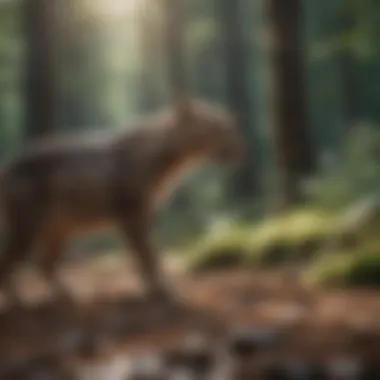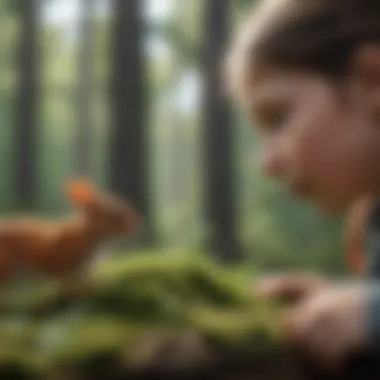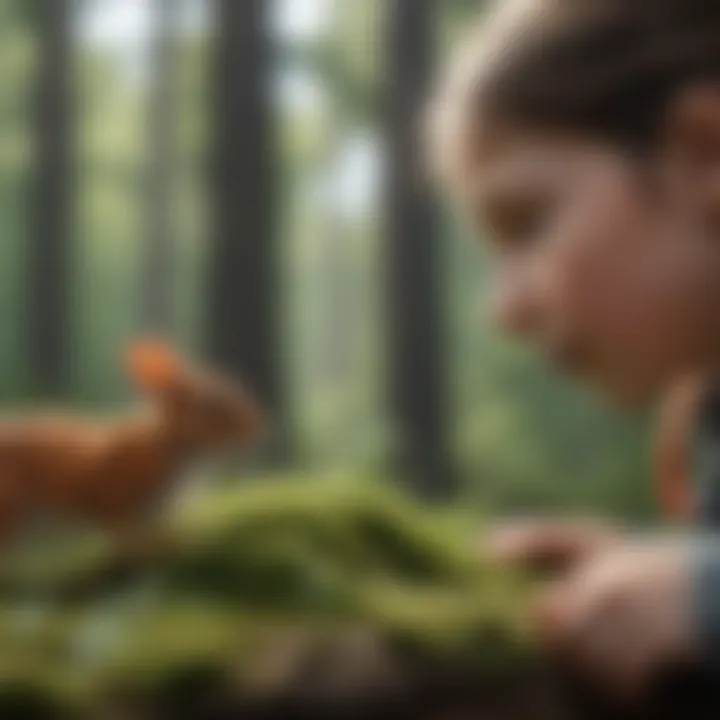Engaging Third Graders with Science Videos


Nature Topic Overview
In the ever-evolving landscape of education, capturing the imagination of third graders is no small feat. Children aged 8 to 9 possess a unique blend of curiosity and critical thinking, making this a pivotal moment for educators and parents. Science videos tailored to this age group can be a powerful tool, effectively bridging the gap between complex scientific ideas and the minds eager to grasp them. As we dive deeper into this topic, it's crucial to understand the role these visual resources can play in the cognitive development of children.
Third graders, like small sponges, soak up information, but they often need the right context to squeeze out an understanding of scientific concepts. Enter multimedia; it’s not just about watching a video, it’s about engaging with content that resonates with them. By using relatable themes, interactive visuals, and element of fun, science videos can turn what once seemed like an abstract idea into something tangible and understandable. From exploring the life cycle of a butterfly to the wonders of the solar system, these resources make learning both enjoyable and informative.
Fun Facts and Trivia
Children love learning when they can uncover surprising facts that fascinate their minds. Here are a few nuggets of information that can spark curiosity:
- Did you know? A single bolt of lightning contains enough energy to toast 100,000 slices of bread!
- Curious cats! House cats share 95.6% of their DNA with tigers, proving that even house pets have a wild side.
- Amazing bees! Honey never spoils! Archaeologists have found pots of honey in ancient Egyptian tombs that are over 3,000 years old and still perfectly good to eat.
Visual and interactive elements like animated quizzes or engaging illustrations can tie in with these facts, creating a multifaceted learning experience that leaves a lasting impression.
Wildlife Explorations
Diving into the wonders of wildlife not only broadens students' horizons, it's also a fascinating way to learn. Young learners can be introduced to a variety of species that share our planet, from the vibrant populations of coral reefs to the majestic creatures roaring in jungles. Each ecosystem brims with unique flora and fauna:
- Tropical Rainforests: Home to thousands of species, including the incredible jaguar and the colorful poison dart frog.
- Deserts: Here you'll find resilient creatures like the fennec fox which has big ears to stay cool.
- Oceans: Explore the depths with the mysterious anglerfish, known for its glowing lure.
Interactive features like quizzes can complement these explorations, helping kids remember key facts while having fun. A simple quiz question like "What helps the anglerfish catch its dinner?" makes the learning process interactive and enjoyable.
Environmental Awareness
Incorporating environmental themes into science videos is particularly important today. As guardians of the planet, even the youngest learners can understand the impact of their choices. Teaching kids about conservation should focus on practical steps they can take. Here are some suggestions:
- Reduce, Reuse, Recycle: Explain the importance of these three R's with engaging visuals showing the journey of a plastic bottle.
- Plant Trees: Show how trees give oxigen and provide habitats, encouraging kids to plant their own trees in school or home gardens.
- Community Clean-Ups: Highlight the significance of keeping nature clean by organizing events, helping kids feel they contribute.
"Every small action counts! Teaching children to love and protect nature ignites a lifelong passion for environmental stewardship."
DIY Nature Activities
Hands-on activities reinforce the lessons learned through video content. Getting children involved in nature can make science stick. Here are some DIY activities:
- Growing Crystals: Kids can create colorful crystals using everyday materials, exploring the science behind crystallization.
- Nature Scavenger Hunt: Create a list of items like specific leaves, rocks, or flowers and let children explore the outdoors while learning to identify local flora and fauna.
- Wildlife Art Projects: Using natural materials like twigs and leaves, kids can create art while discussing the importance of biodiversity.
Step-by-step guides on how to prepare these activities can enhance parent and teacher engagement, providing full support for the learning journey.
By blending vibrant video content with these enriching activities, education becomes an adventure that third graders are eager to embark upon.
The Role of Multimedia in Education
In today’s fast-paced world, the importance of multimedia in education has grown exponentially. Particularly in the early years, when a child’s development and learning style are shaped significantly, multimedia serves as an invaluable companion in the journey of education. Utilizing diverse formats, especially video content, speaks directly to the dynamic ways children absorb information. For third graders, blending visual elements with narrative can cater to various learning styles, be it auditory, visual, or kinesthetic.
Benefits of Multimedia
Multimedia use in education allows for engaging and interactive experiences. It can make learning less of a chore and more of an adventure. Here are some specific advantages:
- Engagement: Video content captures attention, often leading to deeper levels of interest. The vibrant visuals and sounds create an all-encompassing experience that traditional methods may lack.
- Understanding: Complex topics that might leave children scratching their heads suddenly become more tangible when seen in action. Think about how much easier it is to grasp the water cycle when watching it visualized, rather than merely hearing about it.
- Reinforcement: Repetition through multimedia can aid memory. Children can revisit videos at home, allowing them to go over concepts until they grasp them fully.
Despite the evident perks, educators and parents must navigate some considerations when integrating multimedia into learning. Not all videos or multimedia resources are created equal. It’s crucial to ensure that these resources align with educational goals and provide accurate, age-appropriate content. Time spent on screens should be balanced with other forms of learning and playtime to avoid overexposure.
"Multimedia transforms a flat learning experience into a rich, interactive adventure that speaks the language of today’s children."
Understanding Cognitive Development
Understanding how children develop cognitively is foundational to leveraging multimedia effectively. From ages five to twelve, children are in a critical stage of learning. Piaget’s theory of cognitive development emphasizes that children move from concrete operational thought to more abstract reasoning during these years. Science videos play a pivotal role in this transition. They introduce abstract concepts in a visually engaging way, allowing kids to grasp complex ideas through relatable examples.
At around seven to eight years, many children become curious questioners. They thrive on exploring and understanding why things happen. Well-crafted science videos can fuel this curiosity, showing them real-world applications of scientific principles and prompting them to engage with inquiries and experiments.
Why Videos Are Effective Learning Tools
Videos offer a multi-sensory approach to learning that traditional textbooks may not provide. Children, especially third graders, often have short attention spans. Videos keep them engaged by presenting information in chunks—each segment can highlight specific concepts with visuals, sounds, and narratives. This short-and-sweet format can often aid in maintaining focus.


Further, scientific studies suggest that visual aids combined with verbal explanations improve retention rates. A simple yet powerful example is a video on the water lifecycle: seeing evaporation, condensation, and precipitation visually represented can enhance understanding far beyond mere text descriptions.
Video also encourages collaborative learning. A group of kids can watch a science video together, discussing their thoughts, asking questions, and even performing follow-up experiments based on what they learned. Such experiences promote critical thinking and communication skills, making them crucial tools in the educational toolkit.
In essence, the seamless blend of visuals, sounds, and narratives in videos can result in memorable learning experiences, fostering not just knowledge, but a genuine interest in science and discovery.
Science Videos: A Primer
Science videos serve as a crucial bridge between the abstract world of scientific concepts and the tangible understanding of young learners. Tailored specifically for children, these videos can illuminate complex topics through engaging visuals and relatable narratives. This is especially important for third graders, who are at a stage where their cognitive skills are expanding, and they start to connect more deeply with the world around them. By combining education with entertainment, science videos can capitalize on this developmental phase, enhancing not just knowledge but also igniting curiosity.
Defining Science Videos for Children
When we talk about science videos aimed at children, we refer to a specific genre of multimedia content that simplifies intricate scientific principles using visuals, sounds, and stories. These videos often incorporate elements like animations, real-life experiments, and expert explanations, aiming to make learning accessible and engaging.
A science video for kids might introduce a subject like photosynthesis. Instead of dashing through textbook definitions, it could show vibrant plants absorbing sunlight and transforming it into energy. This hands-on depiction resonates well with young minds as they associate visual stimuli with incipient concepts. By placing information in a lively context, children can grasp ideas in a way that a static diagram simply cannot match.
In essence, these videos act as little portals into the world of science, catering to the imagination of children while feeding their intellectual appetite.
Characteristics of High-Quality Science Videos
Not all science videos are crafted equal. When considering what makes a high-quality video, several factors come into play:
- Content Relevance: The information presented must align with educational standards for third graders, keeping in mind their capability to understand concepts.
- Engagement Factor: A video should tell a story or present a challenge that captures attention. A lively presenter, fun characters, or even rhythmic explanations can make a difference.
- Visual Appeal: Colors, animations, and graphics that are attractive to children help maintain focus. If the visuals are engaging, it infuses an extra layer of enjoyment into learning.
- Clarity and Simplicity: While some videos might get too complex, the aim should be to boil down the essence of a topic into bite-sized, digestible bits of information. Clear, straightforward language is vital.
- Interactive Elements: Wherever possible, adding activities or questions at the end of the video can stimulate thinking. Engaging children after watching promotes retention and discussion.
To encapsulate, a quality science video should not just be informative, but also delightful, keeping the engagement of young minds in full bloom. These videos should evoke a sense of wonder, encouraging children to ask questions and explore further.
Themes in Science Videos for Third Graders
Science videos tailored for third graders serve as more than just tools for entertainment; they are crucial for engaging young minds in our ever-evolving world of science. These videos introduce complex concepts through captivating visuals and relatable narratives, helping to make learning both engaging and meaningful. It's important to explore various themes in these videos to cater to children's diverse interests and preferences, ultimately enhancing their learning experience.
Exploring Life Sciences
Life sciences cover a broad spectrum of topics, from the tiniest microorganisms to the vast ecosystems that support life on Earth. Videos under this theme often dive deep into subjects like animal behavior, plant growth, and human biology. They play a key role in fostering respect and understanding for living organisms.
For example, a video showing the life cycle of a butterfly engages the viewer right from the egg stage through metamorphosis into adulthood. Children can see the connection between different life stages, sparking curiosity. Each video can emphasize how organisms adapt to their environments, addressing questions like why animals have certain physical traits or behaviors.
Understanding Earth and Space
The wonders of Earth and space inspire awe and imagination in young learners. Videos that tackle topics about the planet, including weather patterns, geology, and the solar system, feed into children's natural curiosity about where they live and what lies beyond the sky.
Imagine a well-produced video that takes kids on a virtual tour of our solar system. They can explore the different planets and learn fun facts, such as why Jupiter has a Great Red Spot or what makes Venus so hot. This kind of content not only informs but also expands their horizons.
Educators should look for videos that balance scientific information with stunning visuals, ensuring that kids leave with knowledge about both earthly wonders and cosmic mysteries.
Physics Concepts Made Simple
Although often viewed as a complex subject, physics videos tailored for third graders can break down difficult concepts like force, motion, and energy into snippets that are digestible and lively. Simple experiments, presented in videos, allow children to witness physical principles in action.
For instance, a video might demonstrate how pulleys work by showing a toy being lifted with different systems, illustrating the principle of mechanical advantage. These moments illuminate the subject and encourage kids to think critically about observations they make in their daily lives.
Criteria for Selecting Science Videos
When it comes to choosing science videos for third graders, the stakes are high. The right video can spark an interest in science that lasts a lifetime, while the wrong one can lead to confusion and disinterest. Thus, knowing how to select appropriate resources is crucial for both educators and parents. This section aims to shed light on three key factors that should guide the selection process: age appropriateness, content accuracy, and engagement level.
Age Appropriateness
To start off, age appropriateness may seem like a no-brainer, but it often gets overlooked. Videos aimed at older children can use jargon or concepts that go over a third grader's head. It’s essential to select videos that consider not just the child’s age but also their cognitive capabilities. For instance, a video about the water cycle should simplify terms and present visual aids clearly. Using illustrations and animations can make intricate ideas easier to grasp, ensuring that kids don't feel lost in translation.
Moreover, understanding your audience's maturity level helps in framing content that resonates with them. The storytelling style, the types of questions posed, and even the humor employed should align with what a third grader finds relatable. Selecting videos that empower young minds while respecting their developmental stage is a crucial strategy for successful learning.
Content Accuracy
Next on the list is content accuracy. In an era where misinformation can spread like wildfire, it’s vital to pull from credible sources. Science, with its precision and facts, doesn’t do well with inaccuracies. A video that inaccurately represents concepts—whether it’s the process of photosynthesis or the stages of human development—can create misconceptions that children may carry with them beyond the classroom.


Here, teamwork can play a significant role. Engage with reputable educational organizations, such as NASA or National Geographic Kids, to identify videos. These resources often uphold scientific accuracy and age-appropriate content, which means they’ve got a solid footing in real-world facts. For parents, checking out reviews and expert recommendations can be beneficial as well.
Engagement Level
Lastly, let's talk about engagement level. A video might be age-appropriate and contain accurate information, but if it fails to keep a child’s attention, its impact is gone in a heartbeat. Third graders are often bursting with energy and curiosity. A dull video can quickly send them into daydreams not related to the topic at hand.
Look for elements that enhance engagement:
- Interactive Features: Videos that include quizzes or prompts for children to think critically about what they’re watching can make a world of difference.
- Dynamic Visuals: Colorful animations or real-world footage tend to capture attention better than static images.
- Interest-Driven Topics: Videos focusing on popular interests, such as dinosaurs or outer space, tend to draw in kids more effectively.
"An engaging science video is more than just a piece of entertainment; it's a gateway to fostering curiosity and expanding young minds."
When selecting science videos, keeping these criteria in mind can maximize the educational benefits. Age appropriateness, content accuracy, and engagement level work in tandem to create a solid framework for learning. By adhering to these principles, educators and parents can ensure that their children receive rich, meaningful insights into the wonders of the world around them, opening doors to endless exploration.
Integrating Science Videos into Learning
Integrating science videos into the learning environment is an essential step in modern education. These videos serve not just as a repository of knowledge, but as dynamic tools that can enhance children's understanding and retention of scientific concepts. Given the vibrant, tech-savvy world these third graders grow up in, utilizing multimedia aligns perfectly with their learning preferences. Videos can simplify complex ideas, making them more accessible and engaging. The beauty of this integration lies in its capacity to connect theoretical knowledge with real-world applications.
Furthermore, videos can stimulate curiosity in a way that static textbooks often cannot. Kids are more likely to remember content when it’s presented in an engaging and visually appealing manner. This not only aids in comprehension but also fosters a love for science that may last a lifetime. Encouraging students to embark on exploratory journeys through these engaging clips can prompt their natural inquisitiveness, pushing them to ask insightful questions and investigate further.
In the Classroom Setting
In the classroom, science videos can transform a traditional lesson into an interactive experience. For example, if a teacher is covering the topic of ecosystems, a video showcasing different biomes with vivid imagery can help students visualize what they are learning. This becomes especially effective when integrating known program such as BBC Earth or National Geographic Kids, known for their engaging content. The movement, sounds, and visuals not only capture attention but also can illustrate examples that make abstract topics more tangible.
The teacher's role is crucial here. It’s not enough just to show a video; the educator should facilitate discussions afterward. Questions like "What did you find most surprising?" or "How do you think these animals interact with each other?" can engage students on a deeper level and help solidify their understanding.
Moreover, students can work on projects where they create their own videos based on what they’ve learned. This kind of active participation further cements their knowledge while also allowing them to express their creativity.
In the Home Environment
When it comes to the home environment, parents can play a pivotal role in enhancing their child's education through science videos. This could start with a simple family movie night featuring an educational documentary. Platforms like YouTube or Netflix's documentary section are treasure troves filled with material that can be informative yet entertaining.
Combining learning with leisure creates a relaxed space for discussion. Parents can ask questions after watching to gauge comprehension, such as "What was your favorite part of the video?" or "How can we relate what we learned to everyday life?" This not only reinforces what was learned but also helps build critical thinking skills.
Additionally, parents can encourage children to choose videos based on their interests. A child fascinated by outer space, for instance, could delve into shows like Cosmos: A Spacetime Odyssey, igniting passion for science that is personalized and memorable. When learning is linked to a child's personal interests, it becomes more meaningful, thereby enhancing their engagement and understanding.
"Learning becomes a journey when embedded within the realms of interest and curiosity, especially at a young age."
In summary, the integration of science videos into classrooms and homes holds immense potential. It not only makes learning enjoyable; it also ties abstract concepts to visual, emotional, and real-world contexts. This convergence of tools and environments lays a strong foundation for a lifetime of learning.
Evaluation of Video Effectiveness
In this age of digital learning, understanding how to evaluate the effectiveness of science videos becomes crucial for educators and parents alike. Videos can be compelling tools that can enrich children's learning, but their value can only be realized if we can ascertain how well they foster comprehension and critical thinking among third graders. It's not enough for a video to just be colorful and have catchy graphics; we need to determine if it's truly helping them grasp the scientific concepts being presented.
Assessing Comprehension
Evaluating comprehension involves a closer look at how well children understand the material presented in science videos. It's essential to utilize various methods to gauge this understanding. Here are some approaches to consider:
- Pre- and Post-Video Questions: Engage students before and after watching to measure their initial knowledge and improvements. Asking them simple questions can shed light on what they absorbed from the video.
- Discussion and Reflection: Holding discussions post-viewing can stimulate students to articulate their understanding. Encourage them to share their thoughts with peers or in small groups.
- Visual Aids and Story Mapping: Using graphic organizers can help children visualize relationships in what they learned. Story mapping, for instance, could assist in grasping narratives around scientific phenomena.
Moreover, focus on how well they can apply concepts from the video. For example, if a video explains the water cycle, assigning a follow-up activity like drawing the cycle can provide insights into their comprehension. As children narrate the cycle, it can be remarkable to see them make connections that they may not have articulated before. Assessing comprehension isn’t merely about recalling facts; it’s about understanding how they relate to broader concepts.
Encouraging Critical Thinking
The ability to think critically about information sources is essential in today's media-saturated world. Science videos can serve as a springboard for cultivating this skill. Here’s how to promote critical thinking through video engagement:
- Ask Open-Ended Questions: Instead of yes/no questions, pose questions like "What would happen if?" This invites children to explore scenarios and think beyond the video’s content.
- Connect to Real-World Examples: Bringing in real-life applications reinforces learning. For instance, discussing climate change after watching a video about weather patterns can lead to thoughtful discussions.
- Promote Inquiry-Based Learning: Encourage students to formulate their own questions about what they’ve learned and seek answers collaboratively. This instills a sense of curiosity and ownership in their learning.
Incorporating discussions around the video's content into your lesson plan can accelerate critical thinking. For instance, debating the effectiveness of renewable energies shown in videos can lead to a deeper understanding of environmental themes.
"Videos are not just passive viewing experiences; they can initiate active dialogue and reflection among third graders, igniting their enthusiasm for science."


Adopting a comprehensive approach to both comprehension and critical thinking evaluation ensures that science videos do more than just entertain; they become dynamic learning tools that promote essential skills. In doing so, we can elevate the educational experiences of our young learners.
Challenges and Limitations
The integration of science videos into the learning journey of third graders comes laden with both potential pitfalls and essential considerations. While multimedia resources enrich instructional methods, it is crucial to be aware of challenges that might hinder the educational process. This section focuses on two integral aspects: screen time concerns and information overload. Understanding these caveats can help educators and parents navigate the landscape of science education effectively.
Screen Time Concerns
As much as videos can be a gateway to engaging scientific concepts, they also raise valid concerns regarding screen time. Parents often wring their hands over how long children should be glued to a screen. Well, here’s the catch: the American Academy of Pediatrics recommends that children aged 2 to 5 should have no more than one hour of high-quality programming each day. For third graders sitting at the tender age of 8 or 9, this still remains a point of contention.
It's essential to think critically about how science videos fit into a well-rounded day. Parents and educators might keep the following in mind:
- Balance is Key: Mixing video time with physical activity can provide a good counterbalance. Getting kids up and moving helps them process what they’ve watched and reduces the potential negative effects of excessive screen time.
- Mindful Selection: Choosing content that aligns with curriculum goals ensures that time spent on screens is not wasted. High-quality educational content can provide a richer experience compared to casual viewing.
- Interactive Engagement: Encouraging interaction, like asking children questions or discussing the video’s concepts afterward, helps transform passive watching into an active learning experience.
"Video content needs to be a springboard for broader discussion, not just a babysitter."
Information Overload
In today's digital age, information is abundant, often overwhelming. Third graders are naturally curious; however, when they are bombarded with too much at once, it can leave them dazed and confused. This is where the question of information overload arises. With science videos packed with facts, theories, and vibrant visuals, it can be tempting to cover a lot of ground quickly.
To help manage this phenomenon, consider the following strategies:
- Chunking Information: Instead of presenting a full hour of content in one go, break it into manageable bites. For example, watching a 10-minute video followed by discussion allows kids to digest heavier concepts.
- Focused Themes: Stick to one theme or concept per session. When children concentrate on specific ideas, they are far more likely to retain information and engage meaningfully with the material.
- Follow-Up Activities: After a video, connect the concepts to hands-on projects or experiments. This not only reinforces understanding but also prevents the information from becoming cluttered and forgettable.
By acknowledging these challenges, parents and educators can foster a balanced and effective learning environment that maximizes the benefits of science videos while minimizing potential drawbacks.
Future Trends in Science Education
The realm of science education is ever-evolving, and staying abreast with the latest trends is crucial for optimizing learning experiences for young learners, particularly for those in the third-grade bracket. As noted, science videos have proven to be powerful educational tools, but coupling them with innovative technologies and personalized learning experiences can significantly enhance engagement and comprehension for children aged five to twelve. This section sheds light on future directions in science education that educators, parents, and caregivers should be aware of, emphasizing how these trends will reshape the learning landscape and empower students through tailored multimedia resources.
Innovative Video Technologies
Innovative video technologies present a promising horizon in science education. With advancements such as augmented reality (AR) and virtual reality (VR), educators can create immersive learning environments that transport students into the heart of scientific phenomena. Imagine a third grader donning VR goggles to explore the solar system, or interacting with a 3D simulation that illustrates the water cycle. This dynamic form of engagement encourages curiosity and invites exploration.
- Enhanced Visualization: Children often grasp complex concepts more easily when they can visualize them. AR and VR make abstract ideas more tangible.
- Interactive Learning: Features such as quizzes and problem-solving activities within videos can promote active participation, keeping students on their toes.
- Cross-Curricular Connections: New video technologies allow creators to intertwine science with art and history, making lessons more relatable.
"With the right tools, science education transforms into a vivid journey instead of a static lesson."
While adopting these technologies, educators and parents must consider access and the potential need for training. An initial investment may be required for hardware or software, but the long-term benefits for students’ understanding and retention of scientific principles can far outweigh these costs.
Personalized Learning Experiences
A personalized approach to learning respects that each child has unique strengths, weaknesses, and interests. This trend towards customization is rapidly gaining traction in educational settings. Science videos can be tailored to meet these varied learning styles, making content more relatable and impactful.
- Adaptive Learning: Science videos can feature multiple pathways for exploration, allowing children to select topics that pique their interest. For instance, a video on ecosystems might allow the user to choose between focusing on plants, animals, or environmental factors.
- Feedback Mechanisms: Constructive feedback through interactive video content helps students understand what they have learned and where they need to improve, fostering a growth mindset.
- Nurturing Individual Interests: If a student shows interest in robotics, educators can recommend specific science videos that highlight robotics in engineering and technology, aligning the curriculum with the child's passions.
As personalized learning experiences continue to gain acceptance in classrooms, they hold the distinction of being able to respond to the individual pace at which children learn. This helps keep the enthusiasm alive, catering to their curiosity while reinforcing core scientific concepts.
In summary, the future trends in science education—especially regarding innovative video technologies and personalized learning—underscore an exciting pivot towards more engaging, responsive, and effective teaching methods. By embracing these new approaches, we can make science an adventure that young minds are eager to embark on, paving the way for a generation of inquisitive thinkers.
Culmination
In closing, the exploration of science videos tailored for third graders underscores the transformative potential of multimedia in education. These videos serve not merely as supplementary materials but as integrated tools that can dramatically influence the way young learners engage with scientific concepts. By presenting complex ideas in digestible formats, science videos can help bridge the gap between theoretical knowledge and practical understanding.
Summarizing the Impact of Science Videos
Science videos play a pivotal role in nourishing curiosity among children. They make science accessible and entertaining, helping kids see the relevance of what they learn in the classroom to the real world. For instance, a short clip showing the life cycle of a butterfly can spark a child’s interest in biology, encouraging them to look further into nature and its wonders. This impactful medium can help solidify fundamental concepts in a visually striking and memorable manner.
"Children learn best when they can see, touch, and experience. Science videos provide a visual platform that lays a strong foundation for understanding."
Moreover, these educational resources can inspire discussions and foster inquisitive minds. They assist educators in keeping students engaged in the content, which is crucial for retaining information. Through compelling visuals and relatable storytelling, students are likely to remember the knowledge gained long after the video has ended.
Encouraging Lifelong Learning in Science
The effects of integrating science videos into a child's learning journey extend far beyond the classroom. When children are engaged with the content, they develop a natural curiosity which can inspire a lifelong passion for discovery. The use of fun and engaging material motivates young learners to ask questions and seek answers, laying a groundwork that promotes exploration even outside of scheduled learning.
By captivating the imaginations of third graders, these videos not only teach scientific principles but also imbue a sense of wonder about the world. Children absorb information like sponges, and a well-produced educational video can leave lasting impressions that encourage outdoor discoveries or participation in science fairs.
In summary, as we consider the importance of innovation in education, the potential of science videos designed for young learners becomes increasingly clear. They are not just tools for academic knowledge but gateways that lead to a more profound appreciation for science, equipping children with both the knowledge and the inspiration to explore further.







